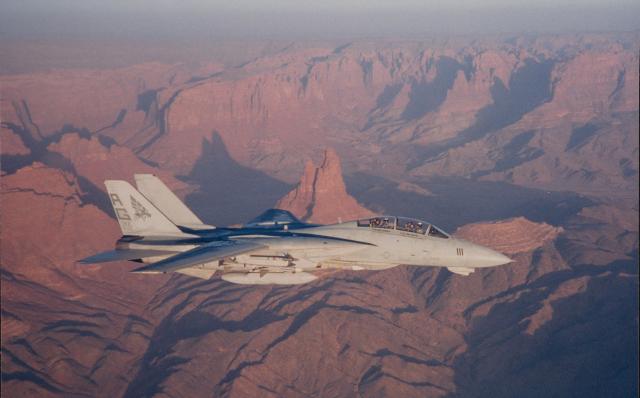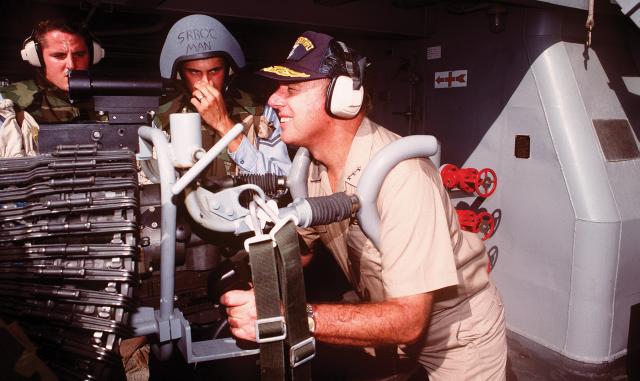This August marks the 30th anniversary of the Iraqi invasion of Kuwait and the launching of Operation Desert Shield, the U.S.-led international response, culminating in January 1991 with the unleashing of Operation Desert Storm—the liberation of Kuwait.
In 1991, the Roland Company collaborated with the U.S. Naval Institute in producing the documentary film Storm from the Sea, which featured extensive interviews with many of the key players in Operation Desert Shield/Desert Storm while the memories were still fresh in their minds. It was the first truly inside, in-depth examination of that still-recent war to be presented to general audiences. In 2017, the Roland Company graciously donated the rights to all interviews and transcripts from the production to the Naval Institute’s archives.
What follows is an excerpt from one of those interviews. At the time of Iraq’s attack on Kuwait, then-Vice Admiral Henry H. Mauz Jr. was serving as Commander, Seventh Fleet; previously, he had been Battle Force Commander during the retaliatory strikes against Libya in 1986. In August 1990, shortly after Saddam Hussein’s Iraqi forces surged over the border into Kuwait, “Hammerin’ Hank” Mauz received word of his appointment as Commander, U.S. Naval Forces, Central Command, for Operation Desert Shield.
On the 2nd of August 1990, I recall well, I was on board my flagship, the USS Blue Ridge (LCC-19), based in Yokosuka, Japan. We had been at sea for the first half of the year most of the time, and we were back for a maintenance period. The word that Iraq had invaded Kuwait reached us, and I thought to myself that Admiral Bill Fogarty, the commander of the Middle East force, was going to be a very busy guy—and did not realize at that time that I would be directly involved so soon.
The phone started ringing, though, to put me on standby. When word did come to get ready to go, we put our battle staff together and were able to go on short notice. On reflection, I think it was an appropriate choice to make at that time, because the Seventh Fleet works with allies and with sister services all the time— extensive exercises, lots of coordination with U.S. air forces in the Far East—and we were used to joint and combined operations. And so we could plug into that scenario very quickly, which we were able to do.
On the 13th of August we flew down to Diego Garcia, and then on up to Bahrain, arriving on the 15th, and my flagship followed behind as fast as she could. On reaching Bahrain on the 15th I was met by the ambassador and Admiral Fogarty and given a message from General Norman Schwarzkopf saying that, upon arrival, I was to take over operation of all the naval forces, which I then set about doing for the next hectic weeks.
At the time we arrived in the Persian Gulf, it was a very tense situation. The U.S. forces were just starting to arrive. We did have a carrier in the Red Sea, the USS Dwight D. Eisenhower (CVN-69). We had a carrier in the North Arabian Sea, the USS Independence (CV-62). Some air forces were starting to come into the theater. The 82nd Airborne was there, and the maritime preposition shipping was coming into theater as well, and the Marines starting to marry up.
But our forces on the ground were very thin, and Iraqi forces were at that time poised on the border between Kuwait and Saudi Arabia, able to come south into Saudi Arabia had they chosen to do so. We didn’t know for sure what their intentions were. It may be that Iraq was going to take a bite off of Kuwait and then wait and see what happened. And had the international reaction not been so swift and strong, and united, it could have been that Iraq would have taken another bite, out of eastern Saudi Arabia.
If you combine the Marine presence that was on the ground, and sustainable, and growing, together with the tactical air presented by the two carriers, then we had a credible defense in the early days. We probably could not have stopped the invasion from occurring had they come south into Saudi Arabia, but we could have slowed them and probably kept them from getting to the vital oil fields. The Marine Air that was arriving at the same time and based out of Bahrain was also a very credible air wing, and it operated in close cooperation with the naval air wings on board the carriers to combine our defensive operations.
The Iraqi naval threat at that time was not considered to be a major factor. We were, of course, concerned with the mines. They had laid mines extensively before, and we were on the watch for that. We had not seen any mines put out in the early days (there was some missile boat activity). But our major concern was the Iraqi tactical aircraft, the Mirage F-1s especially, that could fire Exocet missiles—and had done so in the past. And as they flew over the northern Persian Gulf, our air defenses were very careful and watchful. In some cases, had the Iraqi aircraft kept going another minute or two, they would have been in firing position against our ships, and we would therefore have had to react against them very strongly.
Another important aspect of our operations at that time involved the enforcement of the UN sanctions. We were stopping, boarding, and searching Iraqi ships and all other merchant ships headed to or from Iraq, or the port of Aqaba in Jordan, to make sure that no contraband, no war materials reached Iraq. That was a very touchy situation and very labor intensive for a long time.
At the same time that that was going on, we brought our first amphibious forces into the theater. We had at that time some 13 amphibious ships, which later became 18, then later 31. And those amphibious ships in the early days contributed also to the enforcement of the UN embargo. We had Marines together with Navy SEALs going aboard Iraqi ships by helicopter to secure the ship and stop it for boarding and searching—a very ticklish operation.
One of the lessons that may not be readily apparent from this Southwest Asian conflict is the fact that we were able to bring thousands of shiploads of men and matériel to the region without a single incident along the way. Guaranteed control of the seas. We were able to do that because we had naval forces in the Mediterranean and the western Pacific, and the ability to retaliate should any country along the way think it would be in their interests to try to interfere with our flow of shipping. So, by virtue of having a strong Navy, we were able to obtain the benefit of secure sea lanes.
Without those secure sea lanes, this operation would not have been possible.






